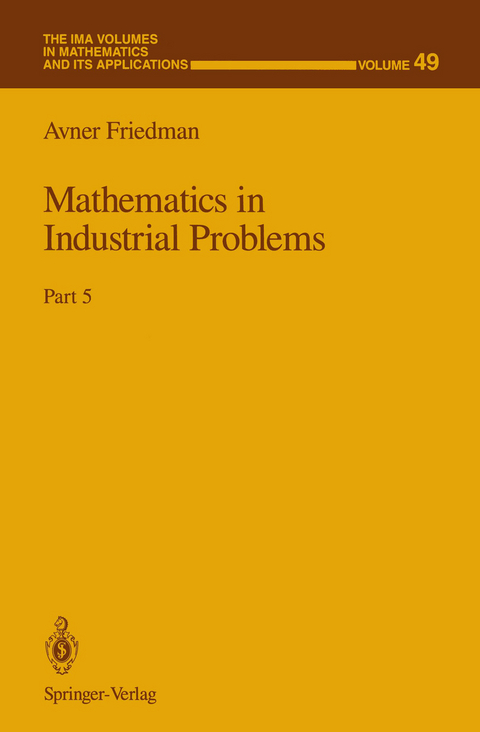
Mathematics in Industrial Problems
Springer-Verlag New York Inc.
978-1-4615-7407-1 (ISBN)
1 Sparse matrix methods for chemical process simulation.- 1.1 Chemical process engineering.- 1.2 Equation based approach to process simulation.- 1.3 The frontal method.- 1.4 References.- 2 High speed coating of optical fibers.- 2.1 Optical fiber manufacturing.- 2.2 Coating of optical fiber.- 2.3 The upper meniscus.- 2.4 An ideal fluid model.- 2.5 References.- 3 Imaging by random coverage.- 3.1 The film.- 3.2 Transmittance and granularity.- 3.3 Moments of the transmission.- 3.4 Photographic granularity.- 3.5 References.- 4 Stress-assisted diffusion in glassy polymers.- 4.1 Diffusion in polymers.- 4.2 Previous models of Non-Fickian diffusion.- 4.3 New formulation.- 4.4 Open problems.- 4.5 References.- 5 Kinetic swelling of crosslinked polymer.- 5.1 The one-dimensional model.- 5.2 Three dimensions: spherical symmetry.- 5.3 The swelling process in general geometry.- 5.4 Solution to problems (1) (2).- 5.5 References.- 6 Stochastic analysis of a slotted communication channel.- 6.1 Slotted channel.- 6.2 Mathematical model.- 6.3 Mathematical results.- 6.4 Open problems.- 6.5 References.- 7 Mathematical problems in color visualization.- 7.1 Areas of applications.- 7.2 Methods of imaging.- 7.3 Characterization of the media.- 7.4 Image processing analysis.- 7.5 Problem areas.- 7.6 References.- 8 Simulated annealing in protein folding.- 8.1 The problem.- 8.2 Numerical approach.- 8.3 Results.- 8.4 Open questions.- 8.5 References.- 9 Ideal forming theory.- 9.1 Rigid-perfectly plastic flow.- 9.2 2-dimensional steady flow.- 9.3 Generalization to 3-dimensions.- 9.4 Mathematical issues.- 9.5 References.- 10 Predicting properties of composite materials.- 10.1 Elastic moduli of a composite.- 10.2 The Hashin—Strikman bounds.- 10.3 Third-order bounds.- 10.4 Homogenization.- 10.5Simulation.- 10.6 Open problems.- 10.7 References.- 11 Interprocessor memory contention.- 11.1 Simulation.- 11.2 Dimensional analysis.- 11.3 Results.- 11.4 Open problems.- 11.5 References.- 12 Computation of volume integrals in potential theory.- 12.1 The general method.- 12.2 Computing boundary and volume integrals.- 12.3 Extensions and open problems.- 12.4 References.- 13 Mathematics of blood analysis.- 13.1 Competitive immuno-assay.- 13.2 Equilibrium and the dose-response curve.- 13.3 The kinetic problem.- 13.4 Liapunov functions for (13.15).- 13.5 References.- 14 Averaged equations for layered and blocky media.- 14.1 Quasistatic equations.- 14.2 The one-cell problem.- 14.3 Discrete contact problem.- 14.4 Application to the unit cell problem.- 14.5 References.- 15 Brownian dynamics simulations of colloidal dispersion.- 15.1 Viscosity divergence.- 15.2 Brownian Dynamics.- 15.3 Simulation.- 15.4 Future directions.- 15.5 References.- 16 Kinetic models of photobleaching.- 16.1 Photobleaching.- 16.2 The kinetic model.- 16.3 Travelling wave solution.- 16.4 Open problems and solution.- 16.5 References.- 17 Micromagnetics.- 17.1 Domains and walls.- 17.2 Equilibrium.- 17.3 The time-dependent problem.- 17.4 Domain-wall calculations.- 17.5 Open problems.- 17.6 References.- 18 A Bayesian framework for computer vision.- 18.1 The Markov random field approach.- 18.2 The mean field approach.- 18.3 Saddle point approximation.- 18.4 Renormalization group technique.- 18.5 References.- 19 Stress from trenches in semiconductor devices.- 19.1 Stress and performance.- 19.2 Stress caused by trench spacing.- 19.3 References.- 20 Solutions to problems from parts 2–4.- 20.1 Part 4.- 20.2 Part 3.- 20.3 Part 2.- 20.4 References.
| Reihe/Serie | The IMA Volumes in Mathematics and its Applications ; 49 |
|---|---|
| Zusatzinfo | 76 Illustrations, black and white; XVI, 216 p. 76 illus. |
| Verlagsort | New York, NY |
| Sprache | englisch |
| Maße | 155 x 235 mm |
| Themenwelt | Informatik ► Theorie / Studium ► Künstliche Intelligenz / Robotik |
| Mathematik / Informatik ► Mathematik | |
| Technik | |
| ISBN-10 | 1-4615-7407-2 / 1461574072 |
| ISBN-13 | 978-1-4615-7407-1 / 9781461574071 |
| Zustand | Neuware |
| Informationen gemäß Produktsicherheitsverordnung (GPSR) | |
| Haben Sie eine Frage zum Produkt? |
aus dem Bereich


